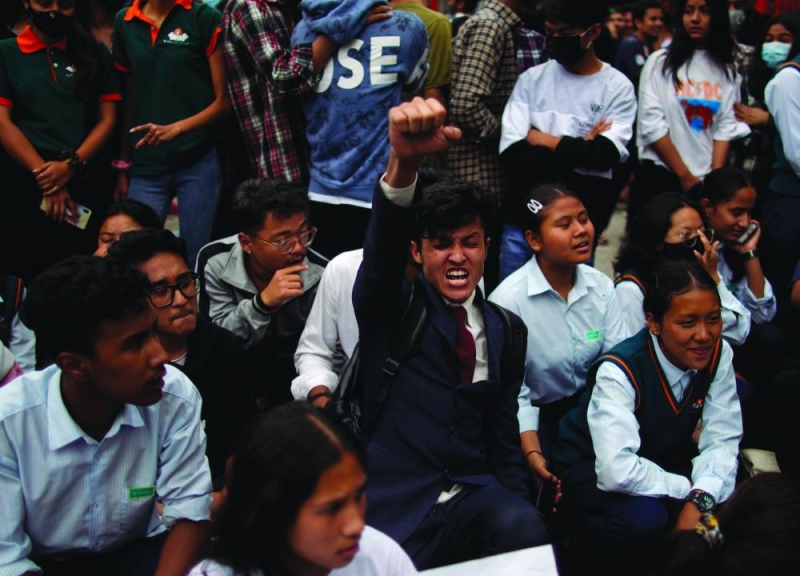Higher education: At home or abroad?
"A significant hurdle that the scholars face in Nepal is the dearth of career opportunities followed by low pay and perks. The unemployment rate is stubbornly high "
Published: 11:17 am Mar 10, 2023
In Nepal, students after their high school education face a dilemma in making a decision.
There are dual options: One is to pursue higher education and look for career opportunities within the country and another one is to leave the country in the quest of greener pastures.
The go-abroad fashion appears more appealing as students fret over the future.
It is high time to contemplate the brain drain of Nepali students.
In the first five months of the current fiscal year, students going abroad for foreign studies have taken about Rs 29 billion in foreign currency. According to Nepal Rastra Bank (NRB), those going for foreign studies from July to November have legally availed the exchange facility of Rs 28.81 billion.
The central bank data clearly show the growing trend of studying abroad where an exodus of people are leaving Nepal for study and foreign employment.
The exodus of migration is on an unprecedented rate and ratio. What will Nepal's future be like? The question looms large amidst the chaos and confusion fueled by the erratic minds of young Nepalis. In fact, the transition from secondary education to high school and high school to higher education is a daunting task. The choices and opportunities available to them are vast and varied but with high stakes. On several occasions, these students weaving dreams in their minds run out of aide or prop or guidance or counselling in their ability to make informed decisions. This is the time when students find themselves floundering in the sea of uncertainties and unpredictability.
On deep analysis of this agenda, there are critical issues that come to the forefront.
The root causes behind the current façade are multifaceted. One such cause stems from the lack of access to quality education.
Another reason for the brain drain is the dearth of career counselling and guidance at home. Added to this, Nepal's education providers are missing the mark to deepen the understanding and failing to train and empower students with skills and credentials needed to vie in the competitive global job market.
In the absence of lifelong education and skills, students are not able to make out choices for better and brighter career prospects.
The indecisiveness of the students leads to a 'leaky pipeline' of talent and potential instigating them to go overseas. This is further lubricated by dropping out in the midst of higher education.
The result is harsh - the students are unable to obtain qualifications and abilities that match the job market.
The problem is exacerbated by the limited economic prospects in Nepal.
Lack of economic opportunities here make it difficult for students to find jobs and build a future for themselves, leading many to seek out greener pastures overseas. For students who do choose to stay in Nepal and pursue higher education, the road ahead is not without its challenges.
The high cost of tuition, coupled with the lack of financial aid and scholarship opportunities and the competitiveness of the job market, makes it difficult for students to find employment after graduation.
However, it is obvious that most of the fellow scholars dive into the foreign shores for better prospects.
This is brain-drain in its prime form. One of the most significant hurdles that the scholars face in Nepal is the dearth of career opportunities followed by low pay and perks. The unemployment rate is stubbornly high, and the job market is highly demanding.
This creates a 'Catch-22'situation where they are unable to secure a job without prior work experience, yet they are unable to do so without a job. This can lead to feelings of inadequacy and frustration, as students struggle to align their aspirations with the realities of academic life.
Nepal's education sector faces critical challenges. One such challenge is failure to ensure full access to quality education for all.
Another problem is the inability to ensure access of specially targeted groups of children to the educational opportunities. Students very often drop out in the middle of their studies. It is imperative to maintain the continuity of enrolled students and achieve high learning outcomes. The government is not able to manage area-wise and subject-wise teachers in all schools. On top of all, schools and colleges fail to focus on technical education to prepare the human resources for the future.
On the other hand, imparting technical and vocational education with skills development has been stressed as a constitutional obligation through the right to education. On the ground, the state is unable to focus on the production of human resource to support a knowledge-based economy. There is a need for making the university education research based. On the one hand, there is a lack of human resources in line with market demand while, on the other hand, the available human resources are seeking employment but failing to get jobs as per their qualification. Another hindrance is the absence of a reading culture and public library system for lifelong education.
The current needs include: enhancing attraction towards public education through universal access, development of proper infrastructure, equitable access and assurance of quality, enhancing educational good governance and accountability, and making the teaching and learning process practical, child-friendly and technology-based so as to prepare entrepreneurial, critical thinking and innovative citizens.
The problems and challenges facing the education sector can be dealt with some concrete strategies.
One strategy is to integrate technical subject areas such as agriculture and forestry, ecology, science and technology, medical science, Ayurveda, tourism, engineering, hydroelectricity, renewable energy, industry and trade with higher education based on national priority. This will be a catalyst to creating an environment for keeping the foreign-bound human resources within the country.
A version of this article appears in the print on March 10, 2023, of The Himalayan Times.



